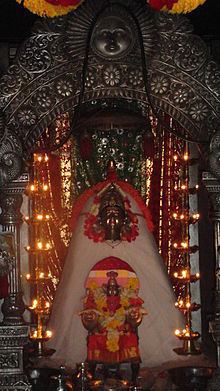Devanagari शांतादुर्गा | Sanskrit transliteration Śāntā durgā Abode Temple | |
 | ||
Mantra OM Aim Hrim Klim Shantadurgabhou Namo Namaha Weapon Idol is arrived from earth Similar Shree Betal temple, Vimleshwar Temple, Mahalasa Narayani Temple, Shanta Durga Temple, Hatimura Temple | ||
Shri Shantadurga (Kalangutkarin) Devasthan Nanora (शांतादुर्गा ) is a Hindu temple in Nanoda village in Bicholim taluka in Goa. The presiding deity is Shantadurga worshiped in the form of Vishweshwari; normally Shantadurga is worshipped in a Shanta form, but it is believed that after killing the demons the deity's anger was soothed and the Shanta Soumya form of fierce Durga Devi is worshiped in Goa. Shri Shantadurga is goddess of Wealth; prosperity; light; wisdom; fortune; fertility; generosity; courage; beauty;Divine; grace; charisma and charm.
Contents
Deity
The temple is dedicated to Shantadurga, the Goddess who mediates between Vishnu and Shiva. The deity is also called 'Santeri' colloquially. Local legends tell of a battle between Shiva and Vishnu. The battle was so fierce that Lord Brahma prayed to Parvati to intervene, which she did in the form of Shantadurga. Shantadurga placed Vishnu on her right hand and Shiva on her left hand and settled the fight.
The deity of Shantadurga is shown as holding two serpents, one in each hand, representing Vishnu and Shiva. She is then said have gone to Kalangut, a village in Bardez Taluka, to helping the people in education, prosperity, good health, beauty. As a reward, she was given the name of Rudaya Mohini. She is referred to as the Goddess of Beauty, Wealth, and Prosperity.
History
The original temple was located in Calangute near Mapusa City Taluka Badez. In the 17th century, due to forceful conversion of Hindus by Portuguese invaders, the temple was shifted to Nanora in Bicholim Taluka, where most such temples shifted. Nanora is situated between city Assonora and Mulgaon in South, Mulgaon is famous for temples which were moved from salcetteTemplate:During Portuguese rule (Shri Dev ShantaDurga Rawalnath Panchaytan Devasthan & Shri Shatadurga Ravalnath Maydekar Devashtan) and Kansarpal in North which is famous for Mahamaya Kalika Devasthan Kasarpal, where as west of Nanora is Advalpal, which is famous for Kuldevta of Goud Saraswat Brahmins Sharvani Devastan and east of Nanora is village of Ladfe and city Bicholim
The main priest is from the Bhuskute family (Kokanstha Brahmins).
Iconography
The main idol in the sanctum sanctorum is more than 800 years old and is in the form of lingam.
Architecture
The modern temple was constructed in the 17th century. It was repaired in the 1990s when the temple was made into a marble masterpiece. The temple has a Dipa Stambha and agrashalas (guest houses).
Devotees
The deity is believed to be patron deity of 96 Kulee Maratha, Kalavants, Bhandari and Rajapur Saraswat Brahmins community spread all over India. Familiar surnames of the devotees are Sawant, Gad Desai, Naik, Kalangutkar,Karangutkar, Desai, Gawas, Vernekar, etc. The Sawant family are spread in Assagao, Virnoda and Mapusa while Gad Desai are spread in Camurlim, Assagao, Keri, Morjim. & Desai are Settle in small Village Called in Pirna of Desai Wada, Pirna Bardez, Goa.
